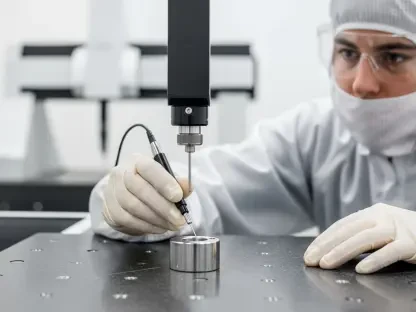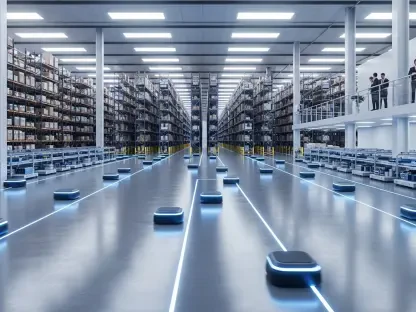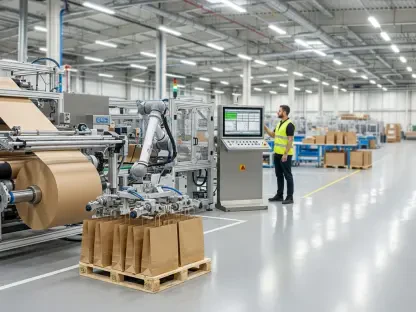Overview of the Pharmaceutical Manufacturing Landscape
The global pharmaceutical manufacturing industry stands at a critical juncture, with an escalating demand for innovative drugs driven by aging populations and the rise of chronic diseases, pushing the sector to adapt rapidly to meet these challenges. Valued at over $1.5 trillion, this sector is a cornerstone of modern healthcare, grappling with the dual pressures of innovation and accessibility. Key segments such as oral medicines, injectables, and active pharmaceutical ingredients (APIs) dominate production efforts, each requiring specialized infrastructure and expertise to meet stringent quality standards.
Major players like Eli Lilly, Pfizer, and Johnson & Johnson lead the charge, investing heavily in technological advancements to streamline operations. Automation, digital tracking, and advanced analytics are transforming production lines, reducing costs, and improving scalability. These innovations are vital as the industry faces increasing scrutiny over drug pricing and supply chain reliability, pushing companies to rethink traditional manufacturing models.
A significant trend shaping the sector is the growing emphasis on localized manufacturing to mitigate risks tied to global supply chains. Disruptions, whether from geopolitical tensions or pandemics, have exposed vulnerabilities in over-reliance on centralized production hubs. As a result, pharmaceutical giants are strategically diversifying their manufacturing footprints to ensure faster delivery and resilience against unforeseen challenges.
Eli Lilly’s Strategic Investment in the Netherlands
Details of the Katwijk Facility
Eli Lilly has committed a substantial $3 billion to establish a state-of-the-art oral medicine manufacturing facility in Katwijk, Netherlands, marking a pivotal expansion in its European operations. Construction is slated to begin next year, with a focus on producing oral solid medicines, including orforglipron, a promising oral GLP-1 receptor agonist for obesity treatment. This facility aims to bolster Lilly’s capacity to address cardiometabolic health needs across the region.
The Katwijk plant will integrate cutting-edge technologies to enhance efficiency and sustainability. Innovations such as dock-to-dock automation, paperless manufacturing processes, and spray-dried dispersion techniques will improve drug absorption and streamline production. These advancements reflect Lilly’s dedication to maintaining a competitive edge in pharmaceutical manufacturing through modernization.
Economic and Regional Impact
Beyond its operational significance, the Katwijk facility is poised to deliver substantial economic benefits to the local area. The project is expected to generate up to 1,500 construction jobs during the building phase and create 500 permanent positions for skilled professionals, including engineers, scientists, and technicians. This influx of employment opportunities will invigorate the regional economy and support community development.
The choice of the Netherlands as the site for this investment underscores the country’s reputation as a hub for life sciences innovation. With a favorable business climate and robust infrastructure, the region offers an ideal environment for pharmaceutical growth. The new facility also complements Lilly’s existing European network, which spans France, Ireland, Italy, and Spain, reinforcing its strategic presence across the continent.
Challenges in Global Pharmaceutical Supply Chains
The pharmaceutical industry faces mounting complexities in meeting the surging global demand for cutting-edge therapies. Rapid advancements in drug development, coupled with varying regional needs, strain existing supply chains, often leading to delays and shortages. These challenges are compounded by external factors like trade barriers and natural disasters, which can disrupt the flow of critical materials.
Scalability remains a persistent hurdle as companies strive to balance production capacity with unpredictable market demands. Overproduction risks waste, while underproduction can hinder access to life-saving medications. Addressing these issues requires a multifaceted approach, including predictive analytics to anticipate demand shifts and flexible manufacturing systems to adapt swiftly to changes.
Localized production emerges as a key strategy to overcome supply chain vulnerabilities. By establishing facilities closer to target markets, companies like Lilly can reduce lead times and transportation costs while enhancing responsiveness. Integrating advanced technologies further strengthens these efforts, ensuring that production remains agile and aligned with global health priorities.
Regulatory and Compliance Considerations
Navigating the regulatory landscape is a cornerstone of pharmaceutical manufacturing, particularly in Europe, where stringent standards govern drug safety and efficacy. Compliance with guidelines set by bodies like the European Medicines Agency (EMA) is non-negotiable, requiring meticulous documentation and rigorous testing at every stage of production. These protocols ensure that patients receive high-quality, reliable medications.
For Lilly, aligning the Katwijk facility with regulatory expectations is paramount, especially for drugs like orforglipron, which is on track for global submission by the end of this year. The company must adhere to timelines for clinical data submission while maintaining transparency with authorities. Such diligence not only facilitates market entry but also builds trust with stakeholders across the healthcare ecosystem.
Moreover, regulatory frameworks increasingly emphasize sustainability and innovation in manufacturing practices. Lilly’s investment in advanced technologies at the Katwijk site aligns with these priorities, demonstrating a commitment to efficient, environmentally conscious production. Staying ahead of evolving compliance requirements will be crucial as the industry adapts to new therapeutic categories and global health challenges.
Future Outlook for Lilly’s Global Manufacturing Strategy
Lilly’s expansive manufacturing strategy, underscored by a cumulative investment of over $55 billion in global facilities in recent years, signals a long-term vision for growth and resilience. While a significant portion—over $50 billion—has been allocated to U.S.-based projects, the focus on international expansions like the Netherlands facility highlights a balanced approach to addressing worldwide demand. This dual emphasis ensures that Lilly can cater to diverse markets effectively.
Emerging trends such as localized production and the rise of advanced therapies are shaping the future of Lilly’s operations. The company is positioning itself to capitalize on personalized medicine and biologics, which require specialized manufacturing capabilities. Investments in automation and digital tools will further enhance precision and speed, keeping pace with the industry’s rapid evolution.
Looking ahead, global health demands, including pandemics and chronic disease prevalence, will likely drive further expansions. Lilly’s strategic site selections and technological integrations provide a blueprint for navigating these pressures. The ability to adapt to regional needs while maintaining a cohesive global network will be a defining factor in sustaining leadership in the pharmaceutical sector.
Conclusion and Strategic Implications
Reflecting on Lilly’s ambitious $3 billion investment in the Netherlands, it becomes evident that this move marks a significant milestone in addressing global healthcare demands through localized manufacturing. The Katwijk facility, with its economic contributions and focus on innovative drugs, stands as a testament to the company’s forward-thinking approach during a time of industry transformation.
For stakeholders, the next steps involve exploring collaborative opportunities to enhance supply chain resilience, such as partnerships with local governments and technology providers to support infrastructure development. Investing in workforce training programs also emerges as a priority to ensure a steady pipeline of skilled talent for future projects.
Finally, a broader consideration is the potential for industry-wide adoption of advanced manufacturing technologies to set new benchmarks in efficiency and sustainability. Lilly’s efforts provide a model for others to emulate, suggesting that strategic investments in innovation and localization could redefine how pharmaceutical companies tackle global health challenges in the years that follow.









